Inscriptions
Browse the RIAo Corpus [http://oracc.museum.upenn.edu/riao/pager/]
1 2 3 4 5 6 7 8 9 10 11 12 13 1001 2001 2002
Annals (texts nos. 1-9)
The Annals of Aššur-bēl-kala are attested in various
versions on different
media: several clay tablets (texts nos. 1, 2, 4, 5, 6, 8,
9), one clay cone fragment (3) and a stone stele, se
so-called "Broken Obelisk" (7).
The identification of these inscription with Aššur-bēl-kala
is due to reasearch work by Weidner, Borger and more
recently Grayson. Still unclear is the exact division of the
different survived parts and whether or not some fragments
belong to the same text. The present electronic edition
follows the division proposed by Grayson (see the discussion
in RIMA 2, p. 87-88).
1
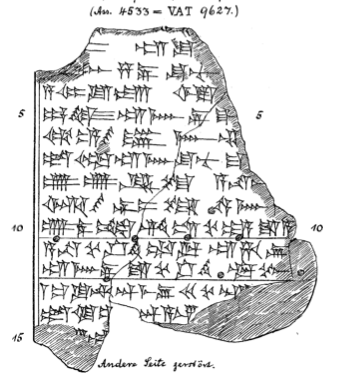
KAH 2, 77
This is the earliest version of Aššur-bēl-kala's annals. All three exemplars are in very fragmentary condition with difficult reading, and the master text is a conflation of all of them. Please consult the scores to see textual details.
Access the composite text [http://oracc.museum.upenn.edu/riao/Q005982/] of Aššur-bēl-kala 01.
Bibliography
2
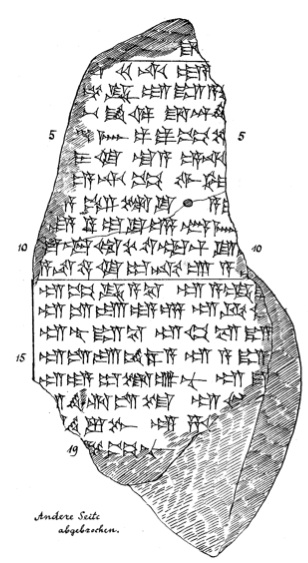
KAH 2, 75
This is a version of the annals written on clay tablets from Ashur, that is later than text no. compared to text no. 1. In addition to that text, here a second campaign to Ḫimme is recorded.
Access the composite text [http://oracc.museum.upenn.edu/riao/Q005983/] of Aššur-bēl-kala 02.
Bibliography
3
A piece of clay cone from Ashur bears two passages from a version of Aššur-bēl-kala's annals, one corresponding to 2 iii 13'-35', and the second recording the reconstruction works on the Step Gate.
Access the composite text [http://oracc.museum.upenn.edu/riao/Q005984/] of Aššur-bēl-kala 03.
Bibliography
4
Two clay tablets from Ashur bear an inscription with the introduction to the annals of Aššur-bēl-kala. Grayson suggests that these fragments could have been part of any of the other annals fragments edited here (see RIMA 2, p. 87-88)
Access the composite text [http://oracc.museum.upenn.edu/riao/Q005985/] of Aššur-bēl-kala 04.
Bibliography
5
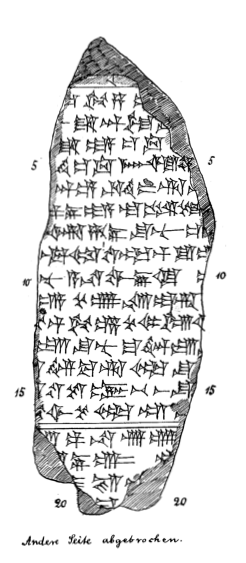
KAH 2, 74
A fragmentary clay tablet from Ashur bears a version fo the annals of Aššur-bēl-kala, with a first portion duplicating the record of the campaign against Uruaṭri as in text no. 2 i 8'-18', the second being an abbreviated version of 2 1 19'-36', and the third being too broken to identify.
Access the composite text [http://oracc.museum.upenn.edu/riao/Q005986/] of Aššur-bēl-kala 05.
Bibliography
6
On a piece of clay tablet from Ashur the remins of five paragraphs have survived. While the first and the last one are too broken for identification, the second and the third paragraphs have a hunting narrative very similar to text no. 7 iv 26-30 (although the division suggests that this text was a variant rather than a copy of no. 7). The fourht paragraph recrods a campaign west of the Euphrates very similar to text no. 9: 3'-10'.
Access the composite text [http://oracc.museum.upenn.edu/riao/Q005987/] of Aššur-bēl-kala 06.
Bibliography
7
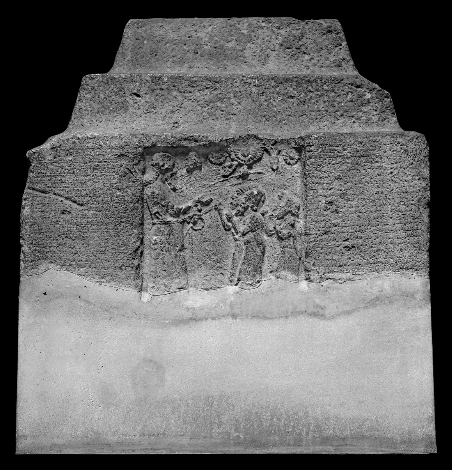
BM 118898 "Broken Obelisk"
A broken stele or "Broken Obelisk," as it is known, was found by archeologist Hormuzd Rassam at Nineveh in a ditch together with text no. 10, but was probably originally from Ashur. The stone object measures 65.4+ x 40.6 cm and is inscribed with a text divided in five columns covering three sides out of four. On the front side, between columns i and ii, a relief has been engraved showing the king leading prisoners, and various divine symbols. The text, which has been attributed with almost certainty to Aššur-bēl-kala, is annalistic and dates to the fifth or sixth year of reign and has to peculiarities. On one hand it seems to be a composition of extracted passages from various sources, including Assyrian chronicles, with little attempt to merge the parts together. On the other hand, the text is not finished, as some parts of it, i.e., the numbers of beasts in the hunting passages, are left blank. The description of hunt is notably long and detailed. The object is thought to have come originally from Ashur, because of the building description, which largely concerns projects at that city.
Access the composite text [http://oracc.museum.upenn.edu/riao/Q005988/] of Aššur-bēl-kala 07.
Bibliography
8
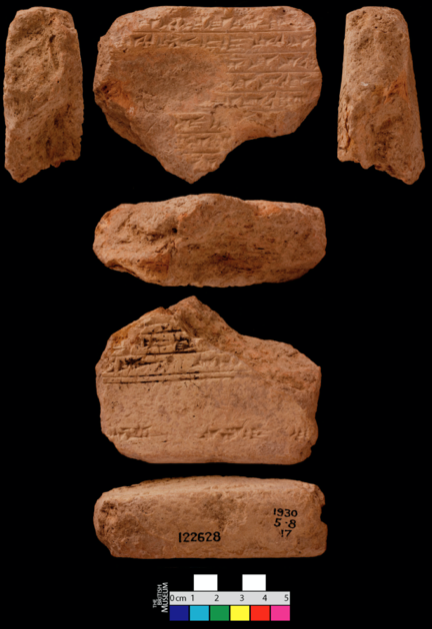
BM 122628
A piece of clay tablet from Nineveh bears a the introductory geneaology and part of the date at the end of an annalistic text. It is possible that this text and no. 9 art part of the same inscription.
Access the composite text [http://oracc.museum.upenn.edu/riao/Q005989/] of Aššur-bēl-kala 08.
Bibliography
9
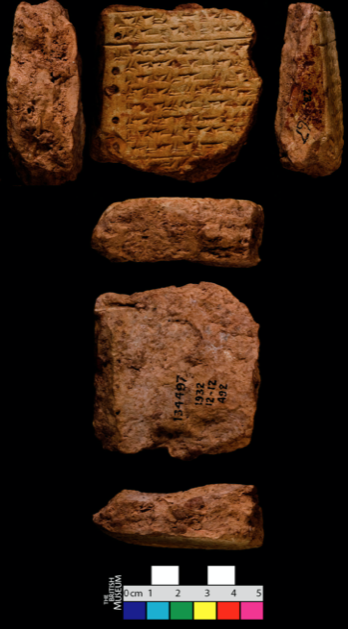
BM 134497
A piece of clay tablet found at Nineveh has an annalistic text from the reign of Aššur-bēl-kala. The name of the ruler is not present in the text, but the inscription has passages that are almost identical with other inscriptions of this ruler: text no. 2 iii 33'-35', 3: 9', andn 7 iv 31-34. The introduction and the final date of this text might correspond to text no. 9.
Access the composite text [http://oracc.museum.upenn.edu/riao/Q005990/] of Aššur-bēl-kala 09.
Bibliography
10
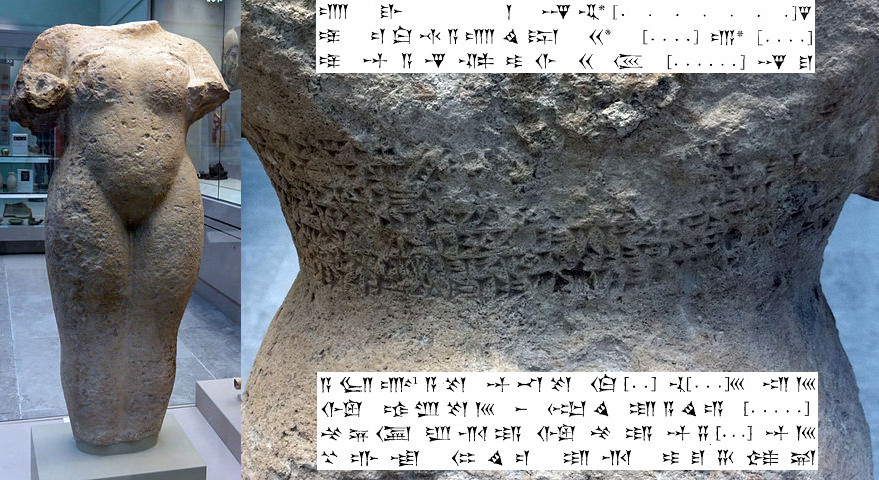
"Assyrian Statue BM 124963"
A stone female statue was found at Nineveh by Hormuzd Rassam in the same ditch with text no. 7. On the statue's torso is engraved this unusual inscription.
Access the composite text [http://oracc.museum.upenn.edu/riao/Q005991/] of Aššur-bēl-kala 10.
Bibliography
11
This short text is inscribed on a stone ornament, probably one of the animal figures from Aššur-bēl-kala's palace at Ashur (see the introductions to Tiglath-pileser I text no. 4 and Aššur-bēl-kala text no. 7; C.J. Gadd suggests that it portrays a type of murena.
Access the composite text [http://oracc.museum.upenn.edu/riao/Q005992/] of Aššur-bēl-kala 11.
Bibliography
12
This five-line inscription of Aššur-bēl-kala is written on hundreds of fragments of a stone sarcophagus, all of which found in a tomb at Ashur; a second uninscribed sarcophagus was discovered with it. Only the very beginning of the text -- which mentions the king by name -- has been published.
Access the composite text [http://oracc.museum.upenn.edu/riao/Q005993/] of Aššur-bēl-kala 12.
Bibliography
13
A stele found in the so-called "row of steles" at Ashur preserves only one sign of the original inscription: a LA sign at the end of the first line. W. Andrae and R. Borger are both of the opinion that the stele ought to be attributed to Aššur-bēl-kala. The text is not sufficiently preserved to warrant an edition.
Access the composite text [http://oracc.museum.upenn.edu/riao/Q005994/] of Aššur-bēl-kala 13.
Bibliography
1001
A badly damaged clay cone from Ashur preserves part of an inscription. A.K. Grayson attributes it to Aššur-bēl-kala because this text and the Broken Obelisk (see text no. 7 [http://oracc.museum.upenn.edu/riao/Q005988/] of this monarch) both mention the land Pizitta. W. Röllig and K. Deller suggest Aššur-uballiṭ I [http://oracc.museum.upenn.edu/riao/thekingdomofassyria13631115bc/ashuruballiti/index.html] as a possible alternative. No edition is given here due to the inscriptions poor state of preservation.
Access the composite text [http://oracc.museum.upenn.edu/riao/Q005995/] of Aššur-bēl-kala 1001.
Bibliography
2001
Tukultī-Mēr, the king of Ḫana, dedicated an inscribed stone object to the god Šamaš at Sippar. The author of this six-line text is assumed to be the man of the same name that Aššur-bēl-kala claimed to have defeated in text no. 1 [http://oracc.museum.upenn.edu/riao/Q005982/]. T. Pinches describes the object as "an oblong instrument, the greater part of green stone, rather flat, rounded off at the broader end, and having the edges also bevelled off. It tapers gradually from the broader end, and is fixed into an ornamental bronze socket, cast or worked into the form of a ram's head, the eyes of which are inlaid with some white composition, the nose terminating in a small ring, from which something formerly hung. At the end to which the bronze part is fixed, and partly covered by it, is engraved, upon one of the broader surfaces, six lines of inscription, in two columns." A.R. Millard suggests that it is a ceremonial whetstone.
Access the composite text [http://oracc.museum.upenn.edu/riao/Q005996/] of Aššur-bēl-kala 2001.
Bibliography
2002
A lapis lazuli bead found in a pharaonic tomb in Egypt is engraved with a short private text of a certain Ibašši-ilu. Because the inscriptions does not mention any particular ruler, its date is uncertain. R. Borger proposes that it belongs to the period of Tiglath-pileser I [http://oracc.museum.upenn.edu/riao/thekingdomofassyria1114884bc/tiglathpileseri/index.html] to Aššur-bēl-kala. A.K. Grayson suggests that the object might date to Aššur-bēl-kala's reign because that monarch received exotic animals from the Egyptian pharaoh (see texts no. 6 [http://oracc.museum.upenn.edu/riao/Q005987/] lines 4'-5', and no. 7 [http://oracc.museum.upenn.edu/riao/Q005988/] iv 29-30). The current location of the bead is unknown.
Access the composite text [http://oracc.museum.upenn.edu/riao/Q005997/] of Aššur-bēl-kala 2002.
Bibliography
Nathan Morello, Jamie Novotny & Poppy Tushingham
Nathan Morello, Jamie Novotny & Poppy Tushingham, 'Inscriptions', The Royal Inscriptions of Assyria online (RIAo) Project, The RIAo Project, a sub-project of MOCCI, 2020 [http://oracc.museum.upenn.edu/riao/thekingdomofassyria1114884bc/ashurbelkala/inscriptions/]